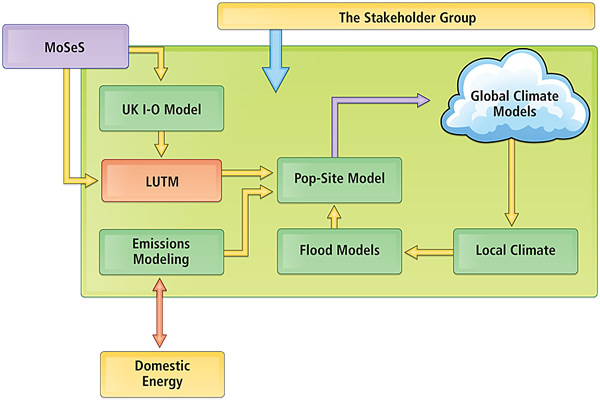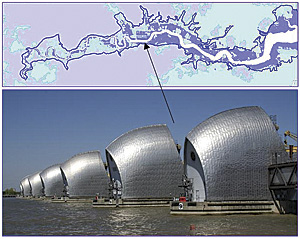Integrated Models and Grand Challenges
By Michael Batty, Centre for Advanced Spatial Analysis, University College London
 The term model has gained widespread currency in the last 25 years as computers have come to dominate our working lives. In this context, we use the term to describe some simplification of our system or problem of interest, which means that we extract and abstract the essence from the situation, developing structures that reflect processes that simulate how geographic systems have developed and evolved. In a sense, we throw away much of the problem and its system when we build a model, for there are strong limits on what we can represent formally in a computer environment, and this means that "good" models must distill the essence of the problem into a form where we can work with it in making good predictions.
The term model has gained widespread currency in the last 25 years as computers have come to dominate our working lives. In this context, we use the term to describe some simplification of our system or problem of interest, which means that we extract and abstract the essence from the situation, developing structures that reflect processes that simulate how geographic systems have developed and evolved. In a sense, we throw away much of the problem and its system when we build a model, for there are strong limits on what we can represent formally in a computer environment, and this means that "good" models must distill the essence of the problem into a form where we can work with it in making good predictions.
A model of a geographic system draws mainly on theoretical notions about the nature of the system whose form and structure we want to predict and from the stakeholders who may want to use that knowledge in policy. The process of representing the relevant geographic system (early desktop GIS, for example) and building a simulation model that captures its essence requires many decisions that are usually considered separately from one another (see "Integrating GIS, Models, and Predictions: The Background"). At one end of the sequence of representation-simulation-prediction, models of the processes involved depend on our theoretical understanding of the system of interest and their implementation in software that links their digital representation to available data. At the other end, model structure and function depend on what predictions are required, the problem they are being designed to inform, and the stakeholders who will use these models in their decision making.
However, as policy has begun to respond to much bigger challenges, such as climate change, and larger-scale models have begun to develop, there has come a need for coupling larger models to form integrated assessments of impacts across a range of spatial and temporal scales.
In this article, we discuss these issues, using as an example the long-term impacts of sea level rise and energy change in the Greater London region.
Integrated Assessment: The Grand Challenge of Climate Change
Ever-larger models and systems of models are being proposed for tackling a new generation of policy problems that are referred to as grand challenges. Chief among these are problems of climate change, energy depletion and transition to alternative sources, demographic aging, and global migration. These kinds of problems are cross-disciplinary in that they are characterized by the meshing of physical and human domains and by transitions across many scales in both space and time. Here we will examine two of these—climate change and its impacts in terms of sea level rise for large cities and energy change through the pricing of gasoline and its impact on short- and long-term transportation behavior.

Our example revolves around an assessment of the potential rise in sea level over the next 100 years in and around the east coast of Britain, with a focus on the impact of such rises on the floodplain of the Thames, the major river on which London sits and whose catchment covers an area with some 20 million people. The worst-case Intergovernmental Panel on Climate Change scenario for sea level rise is two meters by 2100, and if this were to occur, much of the south bank of the river would be flooded in the central area, making several square miles of what is now high-value commercial and residential real estate uninhabitable. Of course, the key issue in assessing such a forecast is to note that over the next 100 years, various mitigation measures will be put in place, which will lead to changed behaviors and reduction of this impact, but as a first shot, we need to simulate this long-term future to get some sense of the scale of the impact. In essence, in the face of population growth over the next 100 years, the question is, what will be the likely impact of such flooding in areas of affected population not only now but in the run up to 2100? To reveal the nature of the problem, we showed the current floodplain and pictured London's current response to rising sea levels—the Thames Barrier (or barrage), on which construction began in 1974 in response to severe flooding due to surge tides that occurred in 1953 (when climate change had barely been thought about).
To handle this kind of forecast, we need some sense of the demographic and economic future, and to this end, two kinds of models are being built by different groups and are being stitched together to produce the future demography and economy of the London region. The MoSeS model, developed by Birkin and his colleagues at Leeds, is a microsimulation model of the UK demographic space and can be run to provide age profiling for fine-scale populations over variable time periods. Its key feature is that it is based on predicting individual spatial behaviors through the construction of a synthetic profile. In contrast, the input-output model MDM-E3 is being adapted by Kohler, Yin, and Barker at Cambridge Econometrics to assess the future employment growth of the region. Both these models generate global forecasts for the London region for different employment and population groups, which are then factored down to small areas and entered into the land-use transportation model (LUTM) to produce population predictions for small areas covering those that are likely to be impacted by flooding. This model has been developed by our group at University College London, but the transport networks that represent four modes of travel—car, bus, rail, and tube—are constructed using the shortest routing representations and algorithms in a GIS, then entered into the LUTM. The group at Newcastle doing this is also building a finer-scale GIS model to translate the activity predictions at the LUTM zonal level to 50-meter grid squares necessary for testing the impact of flooding using flood models, also operationalized by the Newcastle group.

Models chained together to produce the integrated assessment: MoSeS (demographic microsimulation), Input-Output (MDM-E3), LUTM (land-use transportation), Pop-Site (fine scale GIS), Flood (detailed hydrology), and Emissions (external transport). Note that Domestic Energy modeling supports the population location stage of the assessment, and the entire process informs the stakeholder group.
It is quite clear that no one group has the professional and/or intellectual or even practical expertise to construct all these different models. In fact, an important part of the integrated assessment is the use of these models to inform policy through a stakeholder group that represents the key professionals involved in decision making concerning flood risk in Greater London—the UK Environment Agency, Transport for London, the Greater London Authority, etc. To this end, in LUTM, we are developing a rapid prototyping of the land-use transport model, which is visually driven and can generate forecasts quickly (in a matter of seconds) on the desktop and thus can be and is being used directly with the stakeholder group. In this model, we integrate basic desktop GIS functions for visualization, but these are written directly for this purpose and are not loosely coupled to other GIS software. Furthermore, we link these visualization capabilities to external software using free geovisualization software to not only display several layers from the model simultaneously (which the model cannot do) but also capture model outputs as KML files and let users put other raster data into the context so that model outputs can be compared with such external data.
The various models assembled here can also be used to explore many what-if types of scenarios, which can be fashioned in the stakeholder context or generated offline for model testing. There are clearly some very important decisions with respect to how accessible these models are to experts and stakeholders and our capabilities to speedily and effectively visualize and disseminate their results. To this end, there has been a veritable explosion of graphics and multimedia to enable effective communication.
Modeling Changing Energy Regimes
We have also used our LUTM to model the transition to different energy regimes. In terms of our climate change example, a major problem of forecasting long-term change is the altered spatial behaviors that will clearly take place during the long period over which the forecast is being made. If sea level were to rise two meters by the year 2100, then individuals and governments would begin to respond ever more directly and quickly as the year approached. This would lead to natural as well as involuntary changes in location and travel, and this feedback would make itself felt in ways that the models are completely unable to anticipate. This is why such models are largely useful in structuring the debate for mobilizing action and policy rather than providing forecasts that may never be borne out.
In the much shorter term, however, changes in energy prices that are likely to herald the end of the use of oil and other fossil fuels as a serious way of powering conventional transport technologies will have much more immediate impact. When oil rose to $145 a barrel in July 2008, the impact was immediate. People began to switch modes, although switching back was rather fast as soon as oil began its precipitous fall back to its recent longer-term average of about $70 a barrel. To test the immediate impact of such changes, we have used our LUTM to predict mode switching from cars to other forms of public transportation when the price of gasoline is doubled. When this occurs, there is a big switch to other modes, as half of all car riders move to public transportation (note that Greater London has some 38 percent traveling by car in a city area of some 8 million people and the rest by public transport or walking). However, there is a severe limitation in this kind of forecasting. LUTM does not model the supply side of transportation, and thus it is quite impossible for other transport modes to accommodate this surplus of car riders, as these other modes do not have the capacity to respond so in the short term.
In fact, although the elasticity of demand for car travel appears far too high in these predictions—largely because we are not able to assign the predicted trips to a network at a finer scale (in short, because we do not have an integrated transport model within this package)—the actual shifts in population location occasioned from these switches in travel demand are quite small, only in the order of about 3 percent. This is an interesting finding, in that it means that there are many degrees of freedom in the trip-making context that do not show up very much when we compute the trips attracted to each residential area.
Next Steps: Chains of Integrated Models

Above: The River Thames Floodplain—Dark blue is 50 percent risk and light blue is 25 percent risk of severe flooding with 2-meter sea level rise (adapted from the Area Vulnerability Map, Environment Agency, UK Government). Below: The Thames Barrier, constructed to combat surge tides in the North Sea (Credit: www.freefoto.com—Creative Commons).
The problem of integrating multiple models in this fashion was stated in 1968 by William Alonso, who argued that such chains of models might lead to the perpetuation of errors in a way that was uncontrollable. The notion that errors would cancel one another out rather than perpetuate is a matter of blind faith, and there is no way of knowing what will happen if each model is constructed separately and simply chained to its predecessor and successor. This is an argument, then, against integrated modeling, for if a model is constructed "all of one piece," it is likely that the model builder or user will have more sense of the way errors perpetuate within its structure. Alternatively, the whole process might be seen as one piece with the models being tested by the consortium of model builders under controlled conditions. This is equally demanding, but it is possible, at least in principle, and some testing of this kind must be in place to ensure that the overall integrated chain of model operations is stable.
In responding to problems of an interdisciplinary nature in which the grand challenges are the most high profile, integrated modeling of the kind proposed is here to stay. In a world where interconnections across spatial scales from the local to the global and from very short- to very long-term horizons are the norm, it is necessary to embody many different viewpoints in the form of different models that will inform analysis of such problems. In this, it is likely that loosely coupling strings of models, as well as different kinds of software, will become the received wisdom. Urgently required, however, are strategies for dealing with such model structures that need much deeper and extensive verification and validation than the models that now comprise current practice. We began this note with a concern for how models might be integrated with representation and prediction and end it with a new quest to extend representation, simulation, and prediction to many scales and time periods in the search to address major problems such as climate change.
About the Author
Michael Batty is Bartlett professor of planning at University College London, where he directs the Centre for Advanced Spatial Analysis. His research has focused on developing computer models for cities that build on ideas in social physics with an emphasis on visualization and planning support. Trained as an architect-planner, he directed the State University of New York—Buffalo site of the National Center for Geographic Information and Analysis from 1990 to 1995. He is a fellow of the Royal Society.
For additional information, contact Michael Batty (e-mail: m.batty@ucl.ac.uk, Web: casa.ucl.ac.uk).
References
Alonso, W. (1968) "Predicting Best with Imperfect Data," Journal of the American Institute of Planners, pp. 34, 248–255.
Batty, M. (1976) Urban Modelling: Algorithms, Calibrations, Predictions, Cambridge University Press, Cambridge, U.K.
Batty, M. (2010) "Sustainability and Land Use—Transportation Dynamics," in D. Robinson (Editor) Computer Modelling for Sustainable Urban Design, Earthscan, London, forthcoming.
Birkin, M. et al. (2010) "The Elements of a Computational Infrastructure for Social Simulation," Philosophical Transactions of the Royal Society A, pp. 368, 3797–3812
Brail, R. K. (Editor) (2008) "Planning Support Systems for Cities and Regions," Lincoln Institute of Land Policy, Cambridge, MA, pp. 3–30.
Dawson, R., et al. (2009) "A Blueprint for the Integrated Assessment of Climate Change in Cities," in K. Tang (Ed) Green CITYnomics: The Urban War against Climate Change, Greenleaf Publishing, Chippenham, U.K., pp. 32–51.
K�hler, J, Jin, Y., and Barker, T. (2008) "Integrated Modelling of EU Transport Policy: Assessing Economic Growth Impacts from Social Marginal Cost Pricing and Infrastructure Investment," Journal of Transport Economics and Policy, pp. 42 (1), 1–21.
Madden, M. and Batey, P. W. J. (1983), "Linked Population and Economic Models: Some Methodological Issues" Forecasting, Analysis, and Policy Optimization. Journal of Regional Science, pp. 23, 141–164.
Wegener, M. (2005) "Urban Land Use Transportation Models," in D. J. Maguire, M. F. Goodchild, and M. Batty (Editors) GIS, Spatial Analysis, and Modeling, ESRI Press, Redlands, CA, pp. 203–220.
See also "Integrating GIS, Models, and Predictions: The Background."